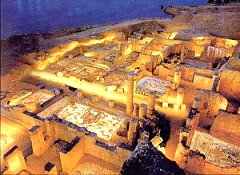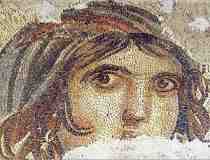 The city is often called Zeuma. A bridge uniting the two banks of the Euphrates (Firat) suggested the name, the Greek work meaning "ayoke", or stands for a term like "bridge head" or "passage location". Pliny (historian) says that Alexander the Great was the first to build a bridge at this point, no doubt a pontoon bridge. Seleucus Nicator repaired it. The Parthians were accustomed to cross the river at this place being the easiest crossing. Cassius camped here in his campaign against the Parthians during the reign of Claudius. In early times two distinct cities, Seleucia and Apamea, had each its opposite bank of the river. It became customary to say that both cities were on the passage of the "Zeugma", and from the first century of our era this name was in current use. Procopius says that Emperor Justinian built a wall during the Byzantine Empire about the city and strongly fortified it. The "Notitia Episcopatum" of Antioch from sixth century mentions Zeugma among the suffrages of Hierapolis. Le Quien mentions several of its bishops: Bassus at Nicea (325); Antonius, an Arian, present at the Council of Philippopolis (344); Sabinianus (363); Aphthonius, at first abbot of a local monastery, later bishop; Heliades, at Ephesus (431); Evocrius at Chalcedon, a city of Bithynia in Asia Minor (todays Kadikoy in Istanbul) (451); Julian (553). Theodoret (historian and religious, 1352-57) deals at length with St. Publius, a monk of Zeugma, and with his monastery.
The city is often called Zeuma. A bridge uniting the two banks of the Euphrates (Firat) suggested the name, the Greek work meaning "ayoke", or stands for a term like "bridge head" or "passage location". Pliny (historian) says that Alexander the Great was the first to build a bridge at this point, no doubt a pontoon bridge. Seleucus Nicator repaired it. The Parthians were accustomed to cross the river at this place being the easiest crossing. Cassius camped here in his campaign against the Parthians during the reign of Claudius. In early times two distinct cities, Seleucia and Apamea, had each its opposite bank of the river. It became customary to say that both cities were on the passage of the "Zeugma", and from the first century of our era this name was in current use. Procopius says that Emperor Justinian built a wall during the Byzantine Empire about the city and strongly fortified it. The "Notitia Episcopatum" of Antioch from sixth century mentions Zeugma among the suffrages of Hierapolis. Le Quien mentions several of its bishops: Bassus at Nicea (325); Antonius, an Arian, present at the Council of Philippopolis (344); Sabinianus (363); Aphthonius, at first abbot of a local monastery, later bishop; Heliades, at Ephesus (431); Evocrius at Chalcedon, a city of Bithynia in Asia Minor (todays Kadikoy in Istanbul) (451); Julian (553). Theodoret (historian and religious, 1352-57) deals at length with St. Publius, a monk of Zeugma, and with his monastery.
Ancient Zeugma City is located in Belkis Village 10 kilometers (6 miles) east from Nizip / Gaziantep, by the Euphrates River. Importance of this settlement which demonstrates an uninterrupted inhabiting since prehistoric ages, is that it is one of the two points allowing the easiest passage across the River Euphrates. The city is an important trade center of Hellenistic Era. After the region started to be ruled by Rome, importance of the city increased upon settlement of a military garrison called 4th Legion. Artistic activities increased and a cultural development is achieved in Zeugma parallel to progress in trade volume. The site of Zeugma was lately discovered and been excavated. Archaeologists discovered many of Roman Villas with beautiful and well preserved floor mosaics.
 The first scientific study which proved that Zeugma is the same place as modern Belkis, was published in 1917. The excavation studies in the ancient city was started in 1992 under the management of Gaziantep Museum Directorate of the Ministry of Culture, General Directorate of Monuments and Museums. French archeology team joined the studies from 1996. Number of villas found since 1992 reached 7. Over 1000 square meters of base mosaic have been found during the excavations performed up to now. During the studies in the region which will fall within the lake area, a Mars statue which is 1.55 meter tall was found on May 03, 2000. Many frescos, mosaics, small objects and ruins of architectural structures have been found during 1999 and 2004. These were moved to Gaziantep and are on display at the Zeugma Museum.
The first scientific study which proved that Zeugma is the same place as modern Belkis, was published in 1917. The excavation studies in the ancient city was started in 1992 under the management of Gaziantep Museum Directorate of the Ministry of Culture, General Directorate of Monuments and Museums. French archeology team joined the studies from 1996. Number of villas found since 1992 reached 7. Over 1000 square meters of base mosaic have been found during the excavations performed up to now. During the studies in the region which will fall within the lake area, a Mars statue which is 1.55 meter tall was found on May 03, 2000. Many frescos, mosaics, small objects and ruins of architectural structures have been found during 1999 and 2004. These were moved to Gaziantep and are on display at the Zeugma Museum.
During the excavations in 1992, an important base mosaic was found in a Rome villa, belonging to Dionysus, however 2/3 of it which is demonstrated in-situ was stolen in 1998. During the excavations during 1993, the terrace mosaics of Rome villas appeared. The 2-figure panel of the mosaic found was cut and extracted as a result of illegal excavations and smuggled abroad 25-30 years ago. It was determined in 1994 that the works are in Houston Menil Collection, and agreement was reached as a result of mutual negotiations, and the mosaics were returned back.
Either Gaziantep Governorship Province Private Administration or Birecik Dam Consortium provided financial contribution to the studies performed, in addition to the resources of the Ministry of Culture of Turkey.
The archeological rescue and documentation studies are carried out under the management of the Ministry of Culture and coordination of SAP, with participation of the Prime Ministry South Anatolian Project Regional Development Administration (SAP-RDA), Packard Humanities Institute (PHI), Birecik Dam and Hep Installation and Operation Co. Inc.
On June 2005, 2nd largest mosaic museum in the world (1st was the one in Bardo/Tunis) was opened in Gaziantep displaying many pieces of unearthed mosaics and Mars statue from Zeugma. With the new additions in 2011, the museum of Zeugma became the largest ancient mosaics indoor museum in the world with over 1700 square meters of Roman mosaics on display. Then in 2014 the mosaics museum in Hatay (Antioch) was opened and became the largest in the world. Today, as of 2022, the largest mosaics museum in the world is the one in Hatay, then Zeugma, and then Bardo/Tunis.
This museum has also a very rich collection of Roman bulla's, seals imprinted in clay, for enclosing documents before "mailing" them. With the discovery of almost 100 thousand of these seals during the excavations, Zeugma now claims first place in the world of this collection. Before Zeugma, the world record was of the Greek islands of Crete and Delos with 21 thousand of them.

